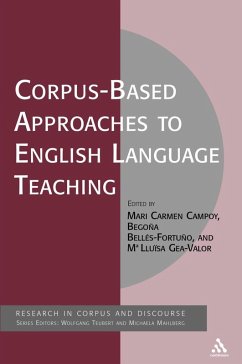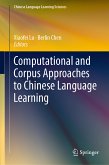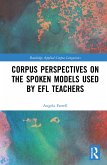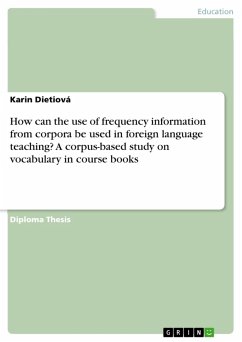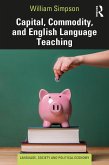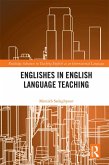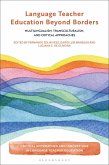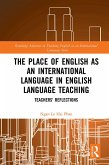Corpus-Based Approaches to English Language Teaching (eBook, PDF)
Redaktion: Campoy, Mari Carmen; Gea-Valor, Maria Lluisa; Belles-Fortuno, Begona
31,95 €
31,95 €
inkl. MwSt.
Sofort per Download lieferbar

16 °P sammeln
31,95 €
Als Download kaufen

31,95 €
inkl. MwSt.
Sofort per Download lieferbar

16 °P sammeln
Jetzt verschenken
Alle Infos zum eBook verschenken
31,95 €
inkl. MwSt.
Sofort per Download lieferbar
Alle Infos zum eBook verschenken

16 °P sammeln
Corpus-Based Approaches to English Language Teaching (eBook, PDF)
Redaktion: Campoy, Mari Carmen; Gea-Valor, Maria Lluisa; Belles-Fortuno, Begona
- Format: PDF
- Merkliste
- Auf die Merkliste
- Bewerten Bewerten
- Teilen
- Produkt teilen
- Produkterinnerung
- Produkterinnerung

Bitte loggen Sie sich zunächst in Ihr Kundenkonto ein oder registrieren Sie sich bei
bücher.de, um das eBook-Abo tolino select nutzen zu können.
Hier können Sie sich einloggen
Hier können Sie sich einloggen
Sie sind bereits eingeloggt. Klicken Sie auf 2. tolino select Abo, um fortzufahren.

Bitte loggen Sie sich zunächst in Ihr Kundenkonto ein oder registrieren Sie sich bei bücher.de, um das eBook-Abo tolino select nutzen zu können.
Corpus-Based Approaches to ELT presents a compilation of research exploring different ways to apply corpus-based and corpus-informed approaches to English language teaching. Starting with an overview of research in the field of corpus linguistics and language teaching, various scenarios including academic and professional settings, as well as English as International Language, are described. Corpus-Based Approaches to ELT goes on to put forward several chapters focusing on error analysis using learner corpora and comparable native speaker corpora. Some of these chapters use translations and…mehr
- Geräte: PC
- mit Kopierschutz
- eBook Hilfe
- Größe: 2.15MB
Andere Kunden interessierten sich auch für
![Computational and Corpus Approaches to Chinese Language Learning (eBook, PDF) Computational and Corpus Approaches to Chinese Language Learning (eBook, PDF)]() Computational and Corpus Approaches to Chinese Language Learning (eBook, PDF)72,95 €
Computational and Corpus Approaches to Chinese Language Learning (eBook, PDF)72,95 €![Corpus Perspectives on the Spoken Models used by EFL Teachers (eBook, PDF) Corpus Perspectives on the Spoken Models used by EFL Teachers (eBook, PDF)]() Angela FarrellCorpus Perspectives on the Spoken Models used by EFL Teachers (eBook, PDF)42,95 €
Angela FarrellCorpus Perspectives on the Spoken Models used by EFL Teachers (eBook, PDF)42,95 €![How can the use of frequency information from corpora be used in foreign language teaching? A corpus-based study on vocabulary in course books (eBook, PDF) How can the use of frequency information from corpora be used in foreign language teaching? A corpus-based study on vocabulary in course books (eBook, PDF)]() Karin DietiováHow can the use of frequency information from corpora be used in foreign language teaching? A corpus-based study on vocabulary in course books (eBook, PDF)36,99 €
Karin DietiováHow can the use of frequency information from corpora be used in foreign language teaching? A corpus-based study on vocabulary in course books (eBook, PDF)36,99 €![Capital, Commodity, and English Language Teaching (eBook, PDF) Capital, Commodity, and English Language Teaching (eBook, PDF)]() William SimpsonCapital, Commodity, and English Language Teaching (eBook, PDF)38,95 €
William SimpsonCapital, Commodity, and English Language Teaching (eBook, PDF)38,95 €![Englishes in English Language Teaching (eBook, PDF) Englishes in English Language Teaching (eBook, PDF)]() Marzieh SadeghpourEnglishes in English Language Teaching (eBook, PDF)42,95 €
Marzieh SadeghpourEnglishes in English Language Teaching (eBook, PDF)42,95 €![Language Teacher Education Beyond Borders (eBook, PDF) Language Teacher Education Beyond Borders (eBook, PDF)]() Language Teacher Education Beyond Borders (eBook, PDF)74,95 €
Language Teacher Education Beyond Borders (eBook, PDF)74,95 €![The Place of English as an International Language in English Language Teaching (eBook, PDF) The Place of English as an International Language in English Language Teaching (eBook, PDF)]() Ngan Le Hai PhanThe Place of English as an International Language in English Language Teaching (eBook, PDF)42,95 €
Ngan Le Hai PhanThe Place of English as an International Language in English Language Teaching (eBook, PDF)42,95 €-
-
-
Corpus-Based Approaches to ELT presents a compilation of research exploring different ways to apply corpus-based and corpus-informed approaches to English language teaching. Starting with an overview of research in the field of corpus linguistics and language teaching, various scenarios including academic and professional settings, as well as English as International Language, are described. Corpus-Based Approaches to ELT goes on to put forward several chapters focusing on error analysis using learner corpora and comparable native speaker corpora. Some of these chapters use translations and their original sources, while others compare the production of learners from different L1 in multilingual learner corpora. Also presented are new tools for corpus processing: a query program for parallel corpora, and the provision of tools to implement pedagogical annotation. The last section discuss the challenges and opportunities that multilayered and multimodal corpora may pose to corpus linguistic investigation. This book will be indispensible to those teaching in higher education and wishing to develop corpus-based approaches, as well as researchers in the field of English Language Teaching.
Produktdetails
- Produktdetails
- Verlag: Bloomsbury eBooks UK
- Seitenzahl: 288
- Erscheinungstermin: 7. Juni 2010
- Englisch
- ISBN-13: 9781441182029
- Artikelnr.: 38301302
- Verlag: Bloomsbury eBooks UK
- Seitenzahl: 288
- Erscheinungstermin: 7. Juni 2010
- Englisch
- ISBN-13: 9781441182029
- Artikelnr.: 38301302
- Herstellerkennzeichnung Die Herstellerinformationen sind derzeit nicht verfügbar.
Mari Carmen Campoy-Cubillo is Senior Lecturer and Head of the Department of English Studies at Universitat Jaume I, Spain > Begona Bellés-Fortuno is a Lecturer in the Department of English Studies at Universitat Jaume I, Spain
I. Corpus Linguistics and ELT: State of the Art
1. Introduction to Corpus Linguistics and ELT (the editors)
2. Using general and specialised corpora in language teaching: Past,
present and future, Ute Römer (University of Michigan, USA)
II. Corpora and English for Specific Purposes
3. Using corpora to teach academic writing, Annelie Ädel (Göteborg
University, Sweden)
4. "I sort of feel like, um, I want to, agree with that for the most
part...": Reporting Intuitions and Ideas in Spoken Academic Discourse,
Begoña Bellés-Fortuño (Universitat Jaume I, Spain) and Mari Carmen Campoy
(Universitat Jaume I, Spain)
5. Hong Kong engineering corpus: empowering professionals-in-training to
learn the language of their profession, Winnie Cheng (Hong Kong Polytechnic
University, Hong Kong)
6. Analysis of organising and rhetorical lexical items in a learner corpus
of technical writing, Maria José Luzón Marco (University of Zaragoza,
Spain)
7. A corpus-informed approach to teaching lecture comprehension skills in
English for Business Studies, Belinda Crawford Camiciottoli (University of
Florence, Italy)
8. Creating a corpus of EIL cross-cultural interaction in the public
domain, Maria Georgieva (Sofia University, Bulgaria) and Lilyana Grozdanova
(Sofia University, Bulgaria)
III. Learner Corpora and Corpus-Informed Teaching Materials
9. Spoken learner corpora and EFL teaching, Sylvie De Cock (Universite
Catholique de Louvain, France)
10. Designing and exploiting a small online English-Spanish parallel corpus
for language teaching purposes, Julia Lavid (Universidad Complutense de
Madrid, Spain), Jorge Arús (Universidad Complutense de Madrid, Spain) and
Juan Rafael Zamorano (Universidad Complutense de Madrid, Spain)
11. English phrasal verbs: A usage-based approach to L2 acquisition, Rafael
Alejo (Universidad de Extremadura, Spain)
12. Analysing EFL learner output in the MiLC project: An error it's*, but
which tag?, Mª Ángeles Andreu Andres, Aurora Astor Guardiola, María Boquera
Matarredona, Penny Macdonald, Begoña Montero Fleta and Carmen Pérez Sabater
(Universitat de Politècnica València, Spain)
13. Focus on errors: Learner corpora as pedagogical tools, Amaya
Mendikoetxea, Susana Murcia and Paul Rollinson (Universidad Autónoma de
Madrid)
14. The monolingual learners' dictionary as a productive tool: The
contribution of learner corpora, Magali Paquot and Sylvie De Cock
(Universite Catholique de Louvain, France)
15. Incorporating learner corpora data in grammar teaching, Tom Rankin
(Vienna University of Economics and Business Administration, Austria)
16. FL students' input in EAP courses in higher education: Corpus
methodology for implementing language representativeness, Izaskun Elorza
(Universidad de Salamanca, Spain) and Blanca García-Riaza (Universidad de
Salamanca, Spain)
IV. Multimodality: Corpus Tools and Language Processing Technology
17. A Generic Tool For Annotating TEI-Compliant Corpora, José Maria
Alcaraz, Pascual Pérez-Paredes, and Encarnación Tornero (Universidad de
Murcia, Spain)
18. Translation and language learning: AlfraCOVALT as a tool for teaching
pragmatics in an EFL context, Josep Roderic Guzmán (Universitat Jaume I,
Spain) and Eva Alcón (Universitat Jaume I, Spain)
19. The videocorpus as a multimodal tool for teaching, Inmaculada
Fortanet-Gómez (Universitat Jaume I, Spain) and Mercedes Querol-Julián
(Universitat Jaume I, Spain)
Bibliography
Index
1. Introduction to Corpus Linguistics and ELT (the editors)
2. Using general and specialised corpora in language teaching: Past,
present and future, Ute Römer (University of Michigan, USA)
II. Corpora and English for Specific Purposes
3. Using corpora to teach academic writing, Annelie Ädel (Göteborg
University, Sweden)
4. "I sort of feel like, um, I want to, agree with that for the most
part...": Reporting Intuitions and Ideas in Spoken Academic Discourse,
Begoña Bellés-Fortuño (Universitat Jaume I, Spain) and Mari Carmen Campoy
(Universitat Jaume I, Spain)
5. Hong Kong engineering corpus: empowering professionals-in-training to
learn the language of their profession, Winnie Cheng (Hong Kong Polytechnic
University, Hong Kong)
6. Analysis of organising and rhetorical lexical items in a learner corpus
of technical writing, Maria José Luzón Marco (University of Zaragoza,
Spain)
7. A corpus-informed approach to teaching lecture comprehension skills in
English for Business Studies, Belinda Crawford Camiciottoli (University of
Florence, Italy)
8. Creating a corpus of EIL cross-cultural interaction in the public
domain, Maria Georgieva (Sofia University, Bulgaria) and Lilyana Grozdanova
(Sofia University, Bulgaria)
III. Learner Corpora and Corpus-Informed Teaching Materials
9. Spoken learner corpora and EFL teaching, Sylvie De Cock (Universite
Catholique de Louvain, France)
10. Designing and exploiting a small online English-Spanish parallel corpus
for language teaching purposes, Julia Lavid (Universidad Complutense de
Madrid, Spain), Jorge Arús (Universidad Complutense de Madrid, Spain) and
Juan Rafael Zamorano (Universidad Complutense de Madrid, Spain)
11. English phrasal verbs: A usage-based approach to L2 acquisition, Rafael
Alejo (Universidad de Extremadura, Spain)
12. Analysing EFL learner output in the MiLC project: An error it's*, but
which tag?, Mª Ángeles Andreu Andres, Aurora Astor Guardiola, María Boquera
Matarredona, Penny Macdonald, Begoña Montero Fleta and Carmen Pérez Sabater
(Universitat de Politècnica València, Spain)
13. Focus on errors: Learner corpora as pedagogical tools, Amaya
Mendikoetxea, Susana Murcia and Paul Rollinson (Universidad Autónoma de
Madrid)
14. The monolingual learners' dictionary as a productive tool: The
contribution of learner corpora, Magali Paquot and Sylvie De Cock
(Universite Catholique de Louvain, France)
15. Incorporating learner corpora data in grammar teaching, Tom Rankin
(Vienna University of Economics and Business Administration, Austria)
16. FL students' input in EAP courses in higher education: Corpus
methodology for implementing language representativeness, Izaskun Elorza
(Universidad de Salamanca, Spain) and Blanca García-Riaza (Universidad de
Salamanca, Spain)
IV. Multimodality: Corpus Tools and Language Processing Technology
17. A Generic Tool For Annotating TEI-Compliant Corpora, José Maria
Alcaraz, Pascual Pérez-Paredes, and Encarnación Tornero (Universidad de
Murcia, Spain)
18. Translation and language learning: AlfraCOVALT as a tool for teaching
pragmatics in an EFL context, Josep Roderic Guzmán (Universitat Jaume I,
Spain) and Eva Alcón (Universitat Jaume I, Spain)
19. The videocorpus as a multimodal tool for teaching, Inmaculada
Fortanet-Gómez (Universitat Jaume I, Spain) and Mercedes Querol-Julián
(Universitat Jaume I, Spain)
Bibliography
Index
I. Corpus Linguistics and ELT: State of the Art
1. Introduction to Corpus Linguistics and ELT (the editors)
2. Using general and specialised corpora in language teaching: Past,
present and future, Ute Römer (University of Michigan, USA)
II. Corpora and English for Specific Purposes
3. Using corpora to teach academic writing, Annelie Ädel (Göteborg
University, Sweden)
4. "I sort of feel like, um, I want to, agree with that for the most
part...": Reporting Intuitions and Ideas in Spoken Academic Discourse,
Begoña Bellés-Fortuño (Universitat Jaume I, Spain) and Mari Carmen Campoy
(Universitat Jaume I, Spain)
5. Hong Kong engineering corpus: empowering professionals-in-training to
learn the language of their profession, Winnie Cheng (Hong Kong Polytechnic
University, Hong Kong)
6. Analysis of organising and rhetorical lexical items in a learner corpus
of technical writing, Maria José Luzón Marco (University of Zaragoza,
Spain)
7. A corpus-informed approach to teaching lecture comprehension skills in
English for Business Studies, Belinda Crawford Camiciottoli (University of
Florence, Italy)
8. Creating a corpus of EIL cross-cultural interaction in the public
domain, Maria Georgieva (Sofia University, Bulgaria) and Lilyana Grozdanova
(Sofia University, Bulgaria)
III. Learner Corpora and Corpus-Informed Teaching Materials
9. Spoken learner corpora and EFL teaching, Sylvie De Cock (Universite
Catholique de Louvain, France)
10. Designing and exploiting a small online English-Spanish parallel corpus
for language teaching purposes, Julia Lavid (Universidad Complutense de
Madrid, Spain), Jorge Arús (Universidad Complutense de Madrid, Spain) and
Juan Rafael Zamorano (Universidad Complutense de Madrid, Spain)
11. English phrasal verbs: A usage-based approach to L2 acquisition, Rafael
Alejo (Universidad de Extremadura, Spain)
12. Analysing EFL learner output in the MiLC project: An error it's*, but
which tag?, Mª Ángeles Andreu Andres, Aurora Astor Guardiola, María Boquera
Matarredona, Penny Macdonald, Begoña Montero Fleta and Carmen Pérez Sabater
(Universitat de Politècnica València, Spain)
13. Focus on errors: Learner corpora as pedagogical tools, Amaya
Mendikoetxea, Susana Murcia and Paul Rollinson (Universidad Autónoma de
Madrid)
14. The monolingual learners' dictionary as a productive tool: The
contribution of learner corpora, Magali Paquot and Sylvie De Cock
(Universite Catholique de Louvain, France)
15. Incorporating learner corpora data in grammar teaching, Tom Rankin
(Vienna University of Economics and Business Administration, Austria)
16. FL students' input in EAP courses in higher education: Corpus
methodology for implementing language representativeness, Izaskun Elorza
(Universidad de Salamanca, Spain) and Blanca García-Riaza (Universidad de
Salamanca, Spain)
IV. Multimodality: Corpus Tools and Language Processing Technology
17. A Generic Tool For Annotating TEI-Compliant Corpora, José Maria
Alcaraz, Pascual Pérez-Paredes, and Encarnación Tornero (Universidad de
Murcia, Spain)
18. Translation and language learning: AlfraCOVALT as a tool for teaching
pragmatics in an EFL context, Josep Roderic Guzmán (Universitat Jaume I,
Spain) and Eva Alcón (Universitat Jaume I, Spain)
19. The videocorpus as a multimodal tool for teaching, Inmaculada
Fortanet-Gómez (Universitat Jaume I, Spain) and Mercedes Querol-Julián
(Universitat Jaume I, Spain)
Bibliography
Index
1. Introduction to Corpus Linguistics and ELT (the editors)
2. Using general and specialised corpora in language teaching: Past,
present and future, Ute Römer (University of Michigan, USA)
II. Corpora and English for Specific Purposes
3. Using corpora to teach academic writing, Annelie Ädel (Göteborg
University, Sweden)
4. "I sort of feel like, um, I want to, agree with that for the most
part...": Reporting Intuitions and Ideas in Spoken Academic Discourse,
Begoña Bellés-Fortuño (Universitat Jaume I, Spain) and Mari Carmen Campoy
(Universitat Jaume I, Spain)
5. Hong Kong engineering corpus: empowering professionals-in-training to
learn the language of their profession, Winnie Cheng (Hong Kong Polytechnic
University, Hong Kong)
6. Analysis of organising and rhetorical lexical items in a learner corpus
of technical writing, Maria José Luzón Marco (University of Zaragoza,
Spain)
7. A corpus-informed approach to teaching lecture comprehension skills in
English for Business Studies, Belinda Crawford Camiciottoli (University of
Florence, Italy)
8. Creating a corpus of EIL cross-cultural interaction in the public
domain, Maria Georgieva (Sofia University, Bulgaria) and Lilyana Grozdanova
(Sofia University, Bulgaria)
III. Learner Corpora and Corpus-Informed Teaching Materials
9. Spoken learner corpora and EFL teaching, Sylvie De Cock (Universite
Catholique de Louvain, France)
10. Designing and exploiting a small online English-Spanish parallel corpus
for language teaching purposes, Julia Lavid (Universidad Complutense de
Madrid, Spain), Jorge Arús (Universidad Complutense de Madrid, Spain) and
Juan Rafael Zamorano (Universidad Complutense de Madrid, Spain)
11. English phrasal verbs: A usage-based approach to L2 acquisition, Rafael
Alejo (Universidad de Extremadura, Spain)
12. Analysing EFL learner output in the MiLC project: An error it's*, but
which tag?, Mª Ángeles Andreu Andres, Aurora Astor Guardiola, María Boquera
Matarredona, Penny Macdonald, Begoña Montero Fleta and Carmen Pérez Sabater
(Universitat de Politècnica València, Spain)
13. Focus on errors: Learner corpora as pedagogical tools, Amaya
Mendikoetxea, Susana Murcia and Paul Rollinson (Universidad Autónoma de
Madrid)
14. The monolingual learners' dictionary as a productive tool: The
contribution of learner corpora, Magali Paquot and Sylvie De Cock
(Universite Catholique de Louvain, France)
15. Incorporating learner corpora data in grammar teaching, Tom Rankin
(Vienna University of Economics and Business Administration, Austria)
16. FL students' input in EAP courses in higher education: Corpus
methodology for implementing language representativeness, Izaskun Elorza
(Universidad de Salamanca, Spain) and Blanca García-Riaza (Universidad de
Salamanca, Spain)
IV. Multimodality: Corpus Tools and Language Processing Technology
17. A Generic Tool For Annotating TEI-Compliant Corpora, José Maria
Alcaraz, Pascual Pérez-Paredes, and Encarnación Tornero (Universidad de
Murcia, Spain)
18. Translation and language learning: AlfraCOVALT as a tool for teaching
pragmatics in an EFL context, Josep Roderic Guzmán (Universitat Jaume I,
Spain) and Eva Alcón (Universitat Jaume I, Spain)
19. The videocorpus as a multimodal tool for teaching, Inmaculada
Fortanet-Gómez (Universitat Jaume I, Spain) and Mercedes Querol-Julián
(Universitat Jaume I, Spain)
Bibliography
Index
